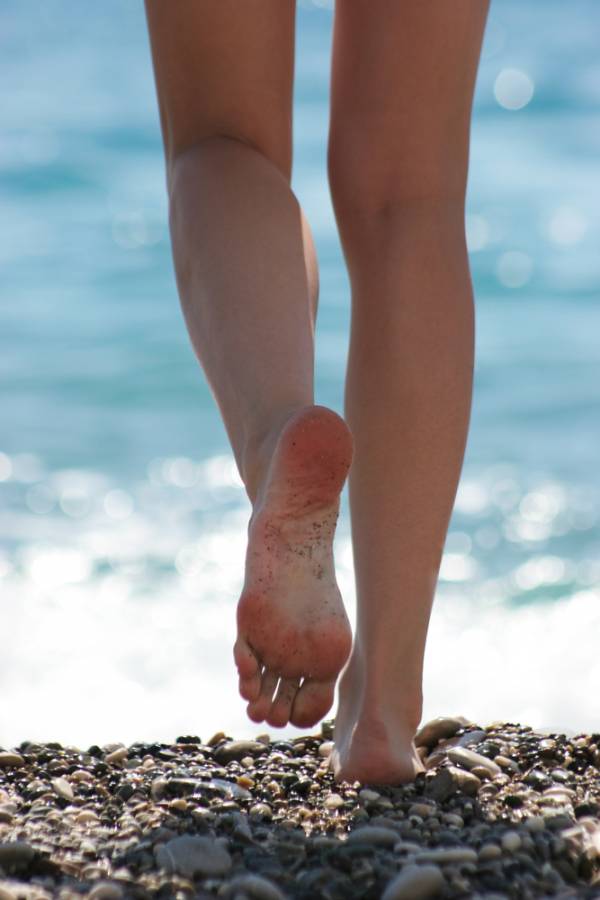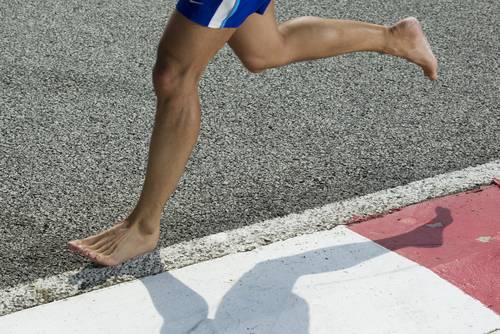Barefoot running, zero drops, negative heels, foot gloves, sandals or moccasins, these are some of the current trends in the running and fitness world. There is a growing consciousness around the long forgotten feet and their important role they play in our life. Without them, our lives would look very different. Why you would try out minimalist running and where you would begin all depends on what your goals are and what surface your feet tread on.
Ask Yourself – Why Go Minimalist?
Why has this trend seen a reemergence in the past five years? I believe people are sick and tired of injuries and the rising costs of footwear that need to be replaced every six hundred miles.
I was one of these people. Over the last six years my running goals have changed. What started as goals of personal records for marathons evolved to a goal of running without injuries. In these six years, I have run three marathons, three Hood to Coast Relays, and about eight half-marathons. My training mileage is anywhere from twenty to fifty miles per week.
For the last three years, I have been running with a variety of minimal footwear and I just completed my first marathon in my rubber soled foot gloves. I started this journey looking for some other method than what felt like a downward spiral into injury abyss, with collapsing arches, bunions, shin splints, sore knees, and weak hips. Orthotics, toe wedges, tape, neutral shoes, stabilizing shoes, three pairs of shoes to rotate – it was just exhausting. I had to put so much effort into my foot wear before a run that it became less time playing and more time working around injuries.
If you are thinking about going with the “less is more” footwear and mindset, here are things to consider:
- Why? What do you hope to gain in transitioning to minimalism?
- What activity will you be using the footwear for?
- How much mileage in a week will you be running/walking?
- What is the surface your feet will be on for this activity?
- Do you walk barefoot around the house or outdoors already?
- How sensitive are your feet if you walk on pavement? Gravel? Bark dust? Dirt and trails?
- Do you currently have injuries?
Answering these questions will be essential for your transitioning smoothly into minimalism. Take these questions to a trained coach who runs in minimal footwear or send them to dearwillow@breakingmuscle.com for tips and techniques to help you transition smoothly.
How Shoes Affect Feet
 There are twenty-six bones in each foot on average, plus the tibia and fibula of the lower leg. There are around a hundred muscles, tendons, and ligaments around the foot and ankle. When your feet are in shoes for the majority of your waking day, there is a compression of these bones and muscles that limits blood flow and weakens the supportive nature of your feet. Range of motion decreases and muscles that once helped us navigate the terrain we step upon weaken and become less useful for proprioception (balance and positioning of body).
There are twenty-six bones in each foot on average, plus the tibia and fibula of the lower leg. There are around a hundred muscles, tendons, and ligaments around the foot and ankle. When your feet are in shoes for the majority of your waking day, there is a compression of these bones and muscles that limits blood flow and weakens the supportive nature of your feet. Range of motion decreases and muscles that once helped us navigate the terrain we step upon weaken and become less useful for proprioception (balance and positioning of body).
Transition Instead of an Immediate Switch
It takes months to build up the strength in the intrinsic and extrinsic muscles of the feet and ankle. This strengthening process puts additional strain and demands on the bones, thus requiring we take additional time to gradually build up bone density.
How to Transition:
- If you currently run/walk many miles per week in shoes, I recommend getting a pair of shoes with half the heel height you are currently wearing, then change into these for the last half of your runs/walks. The idea here is to ease into a lower heel, as it will be a shock for your Achilles to go from a full inch lift to just millimeters. Doing so too quickly can bring a quick tendinopathy in the Achilles or plantar fascia, strains, shin splints, and a host of other physical anomalies.
- After a month or two, switch entirely to the lower heeled footwear for your run/walks. Continue for three to six months. If you decide to continue lowering your heel, find footwear that has zero or very little sole surface, such as the rubber soled foot gloves.
- If you want to go full foot gloved or barefoot after you have transitioned fully to zero heel lift and feel injury free for several months, first begin calf, plantar, and toe strengthening exercises. Start by walking in a park or trail barefoot for approximately ten minutes. Afterwards, you may notice your feet buzzing with energy currents for a couple hours. This process means the nerves on your feet are waking up and sending data to your brain about how to enhance proprioceptive mapping and recruit weak muscles to support your next barefoot venture.
 Notice the new positioning of your body when running with minimal footwear. In my experience, there is less compression as the main joints are working together to displace and disperse shock and compression. I don’t hear the scuffing of shoes across the pavement because my legs are stronger and lift my feet higher off the ground. I don’t roll my ankles stepping off curbs or rocks because my feet have heightened sensory acuity to what is under them and my body responds faster to avoid a fall or twist. Overall, I feel more relaxed and natural when running for minutes to hours. I call this “Sublime Running.”
Notice the new positioning of your body when running with minimal footwear. In my experience, there is less compression as the main joints are working together to displace and disperse shock and compression. I don’t hear the scuffing of shoes across the pavement because my legs are stronger and lift my feet higher off the ground. I don’t roll my ankles stepping off curbs or rocks because my feet have heightened sensory acuity to what is under them and my body responds faster to avoid a fall or twist. Overall, I feel more relaxed and natural when running for minutes to hours. I call this “Sublime Running.”
Be patient and heed your body’s signals during your transitioning period. There are no overnight made elite athletes; there will be no overnight success in your transition. The transition itself is a marathon and will take time to achieve. Run through the finish line with minimal injuries, as well as footwear.






